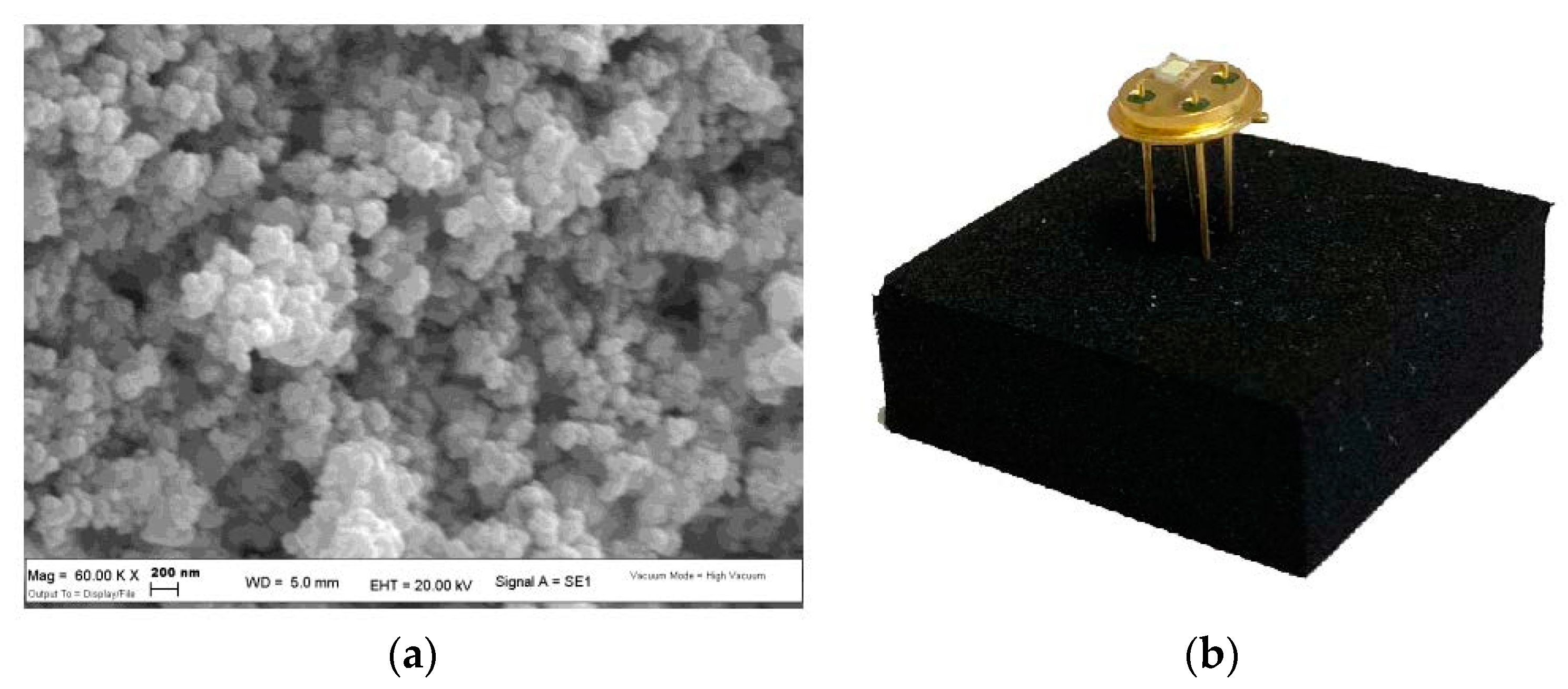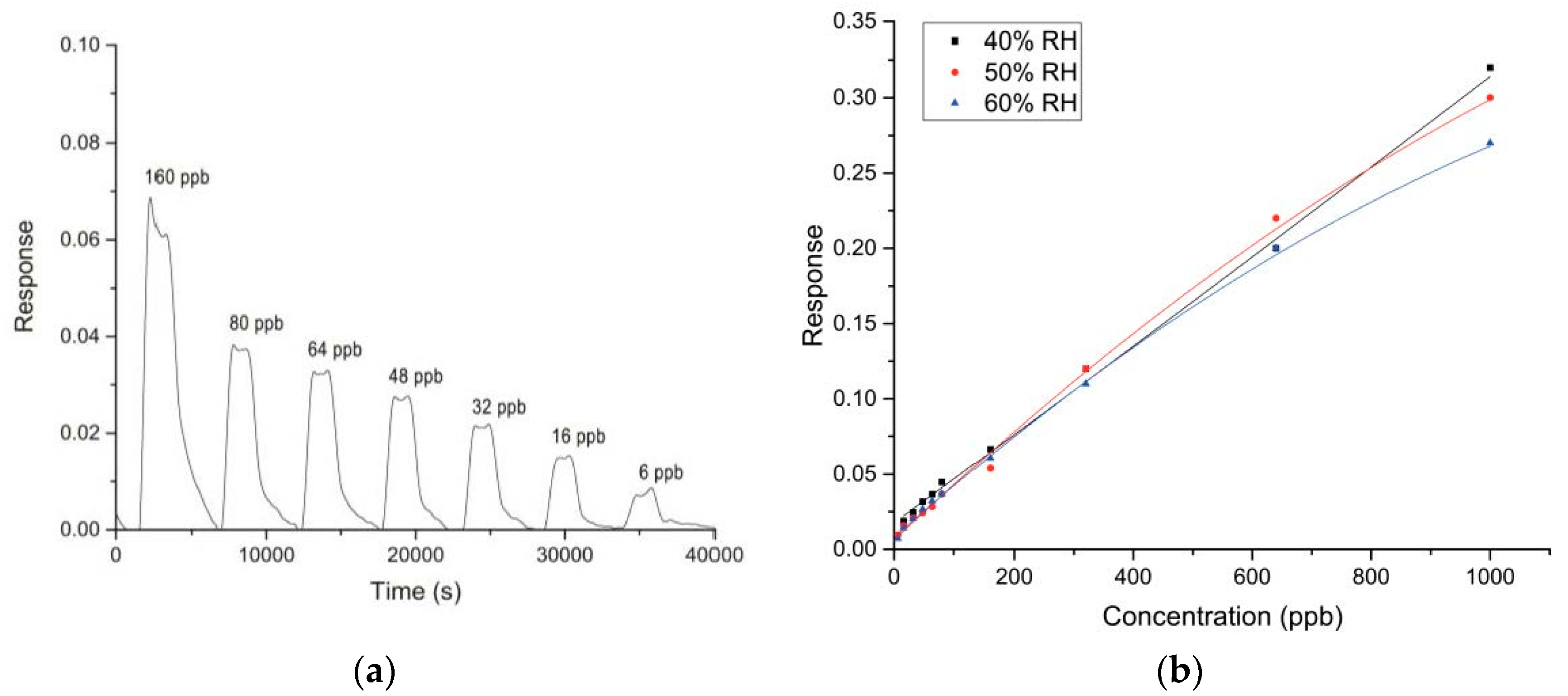Glyphosate Detection: An Innovative Approach by Using Chemoresistive Gas Sensors †
Abstract
:1. Introduction
2. Materials and Methods
2.1. Sensing Materials
2.2. Glyphosate Sensing Measurements
3. Results and Discussion
3.1. Sensing Materials
3.2. Glyphosate Sensing in Air
4. Conclusions
Author Contributions
Conflicts of Interest
References
- Franz, J.E.; Mao, M.K.; Sikorski, J.A. Glyphosate: A Unique Global Herbicide; American Chemical Society: Washington, DC, USA, 1997; ISBN 0841234582. [Google Scholar]
- Portier, C.J.; Armstrong, B.K.; Baguley, B.C.; Baur, X.; Belyaev, I.; Budnik, L.T. Differences in the carcinogenic evaluation of glyphosate between the International Agency for Research on Cancer (IARC) and the European Food Safety Authority (EFSA). J. Epidemiol. Community Health 2016, 70, 741–745. [Google Scholar] [CrossRef] [PubMed]
- Gill, J.P.K.; Sethi, N.; Mohan, A. Analysis of the glyphosate herbicide in water, soil and food usingderivatising agents. Environ. Chem. Lett. 2017, 15, 85–100. [Google Scholar] [CrossRef]
- Ding, J.; Guo, H.; Liu, W.; Zhang, W.; Wang, J. Current progress on the detection of glyphosate in environmental samples. J. Sci. Appl. Biomed. 2015, 3, 88–95. [Google Scholar]
- González-Martínez, M.A.; Brun, R.; Puchades, E.M.; Maquieira, A.; Ramsey, K.; Rubio, F. Glyphosate Immunosensor. Application for Water and Soil Analysis. Anal. Chem. 2005, 77, 4219–4227. [Google Scholar] [CrossRef] [PubMed]
- Bataller, R.; Campos, I.; Laguarda-Miro, N.; Alcañiz, M.; Soto, J.; Martínez-Máñez, R.; Gil, L.; García-Breijo, E.; Ibáñez-Civera, J. Glyphosate Detection by Means of a Voltammetric Electronic Tongue and Discrimination of Potential Interferents. Sensors 2012, 12, 17553–17568. [Google Scholar] [CrossRef] [PubMed]
- Guidi, V.; Malagu’, C.; Carotta, M.C.; Vendemiati, B. Printed semiconducting gas sensors. In Printed Films: Materials Science and Applications in Sensors, Electronics and Photonics; Woodhead Publishing Series in Electronic and Optical Materials; Woodhead Publishing Ltd.: Cambridge, UK, 2012; Chapter 11; pp. 278–334. [Google Scholar] [CrossRef]
- Guidi, V.; Carotta, M.C.; Fabbri, B.; Gherardi, S.; Giberti, A.; Malagù; C Array of sensors for detection of gaseous malodors in organic decomposition products. Sens. Actuators B 2012, 174, 349–354. [Google Scholar] [CrossRef]



| Channel | CH1 | CH2 | CH3 | CH4 | CH5 | CH6 | CH7 | CH8 |
|---|---|---|---|---|---|---|---|---|
| Sensor | STN | WS30 | SnMo | ZnO | ST20 | ST20 Si | WS30 | STN |
| Working Temperature [°C] | 450 | 450 | 400 | 450 | 450 | 450 | 450 | 450 |
Publisher’s Note: MDPI stays neutral with regard to jurisdictional claims in published maps and institutional affiliations. |
© 2018 by the authors. Licensee MDPI, Basel, Switzerland. This article is an open access article distributed under the terms and conditions of the Creative Commons Attribution (CC BY) license (https://creativecommons.org/licenses/by/4.0/).
Share and Cite
Fabbri, B.; Valt, M.; Gaiardo, A.; Gherardi, S.; Malagù, C.; Guidi, V. Glyphosate Detection: An Innovative Approach by Using Chemoresistive Gas Sensors. Proceedings 2018, 2, 910. https://doi.org/10.3390/proceedings2130910
Fabbri B, Valt M, Gaiardo A, Gherardi S, Malagù C, Guidi V. Glyphosate Detection: An Innovative Approach by Using Chemoresistive Gas Sensors. Proceedings. 2018; 2(13):910. https://doi.org/10.3390/proceedings2130910
Chicago/Turabian StyleFabbri, Barbara, Matteo Valt, Andrea Gaiardo, Sandro Gherardi, Cesare Malagù, and Vincenzo Guidi. 2018. "Glyphosate Detection: An Innovative Approach by Using Chemoresistive Gas Sensors" Proceedings 2, no. 13: 910. https://doi.org/10.3390/proceedings2130910
APA StyleFabbri, B., Valt, M., Gaiardo, A., Gherardi, S., Malagù, C., & Guidi, V. (2018). Glyphosate Detection: An Innovative Approach by Using Chemoresistive Gas Sensors. Proceedings, 2(13), 910. https://doi.org/10.3390/proceedings2130910








